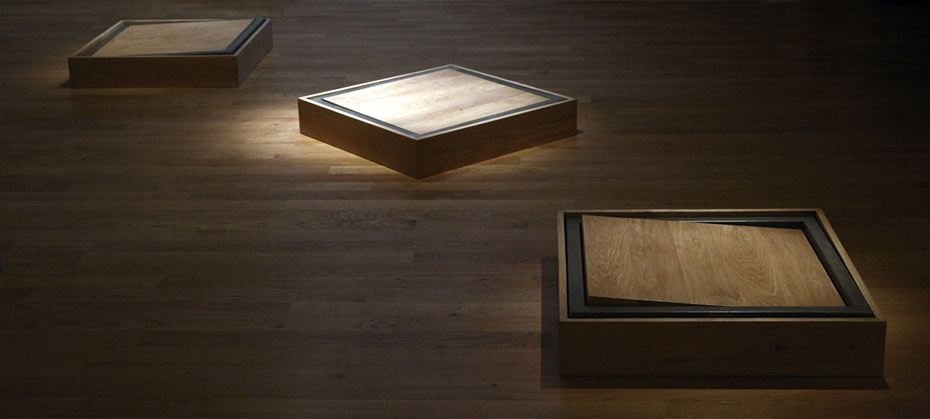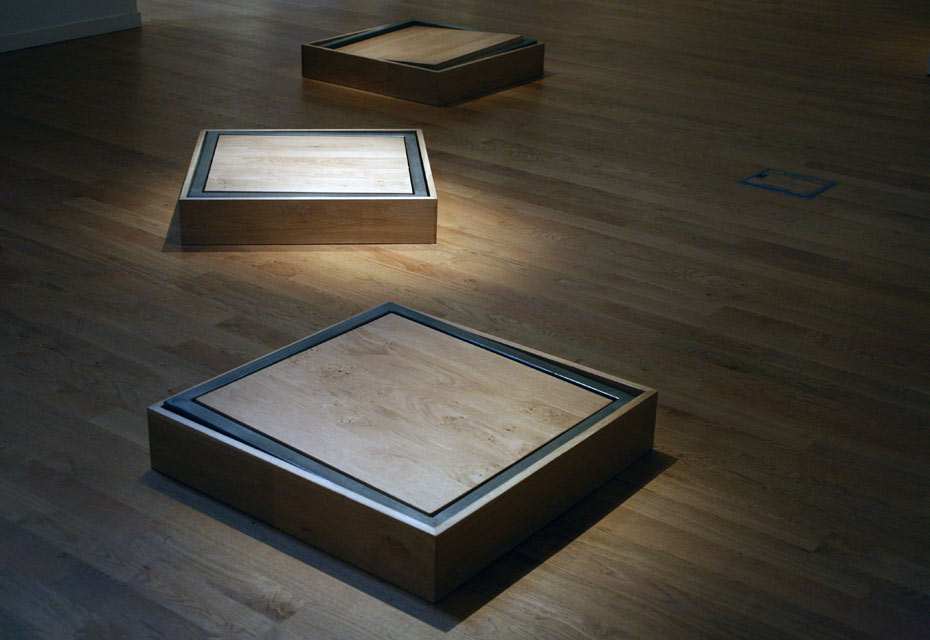Le paysage est instable et mouvant, vivant, il est en perpétuelle métamorphose.
La Terre vibre sous nos pieds, son activité est cachée, contenue et, à tout moment, peut exploser : cicatrice, fissure, tremblement de terre, magma en fusion.
Charlotte Charbonnel a cherché ce rapport physique au sol mouvant.
Magma est une sculpture mécanique qui se compose d’un plateau et de deux cadres articulés et fixés sur des axes.
Ces deux degrés de liberté permettent une mobilité de gauche à droite et d’avant en arrière.
Ces trois Magma font partie d’un ensemble de cinq qui symbolisent les cinq continents : comme une entrée possible vers chaque terre.
Le dessous de cette écorce, l’envers et l’endroit de la surface ont motivé les recherches de cette sculpture.
Elle devient le véhicule de ce qui est caché, c’est-à-dire le dessous, et interroge l’intérieur de la sculpture.
Il s’agit de mettre en évidence le rapport du corps face à une sculpture, sa position dans un espace, son adaptation à un environnement en mouvement et qui peut basculer.
Le paysage, cette immensité que l’on ne peut embrasser, est ici matérialisé par une forme primitive, simple, géométrique et universelle : un carré.
Ces trois carrés sont d’apparence identique, mêmes matériaux, mêmes dimensions, mais leur singularité se trouve à l’intérieur.
Le visiteur fait l’expérience physique de cette sculpture « praticable », afin d’en ressentir sa mobilité, ses perturbations et d’essayer de trouver l’équilibre.
The sculpture is unstable and moving, living in perpetual metamorphosis.
The Earth vibrates under our feet, its activity is hidden, contained, and at any moment could explode: scars, fissures, earthquakes, molten magma.
This work examines the physical relation to the moving ground.
Magma is a mechanical sculpture composed of a plateau and of two frames articulated and fixed on axes.
These two degrees of liberty permit a mobility from left to right and front to back.
These three Magma are part of an ensemble of five, which symbolize the five continents: like a possible entrance at each of the lands.
The bottom of each exterior; the opposite and the place of the surface motivated the research for this sculpture.
The sculpture becomes the vehicle for what is hidden, the underside, and questions the interior of the sculpture.
Charlotte Charbonnel wanted to highlight the relationship of the body facing a sculpture, its position in a space, its adaptation to an environment in constant movement, capable of toppling over.
The landscape, this vastness which no one can encompass in its entirety, is materialized here by a primitive form, simple, geometric, and universal: a square.
The three squares appear to be identical: same materials, same dimensions—but their singularity is found within.
The visitor physically experiences this « practicable » sculpture in order to feel its mobility, its perturbations, and to try and find equilibrium.



